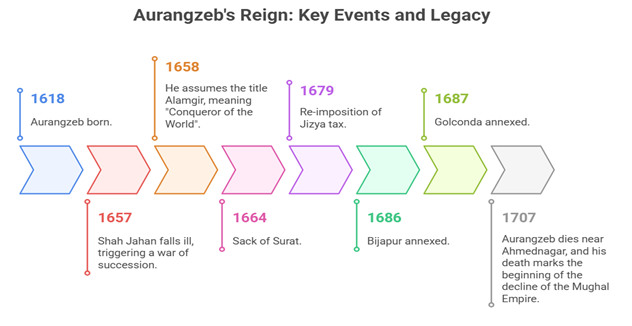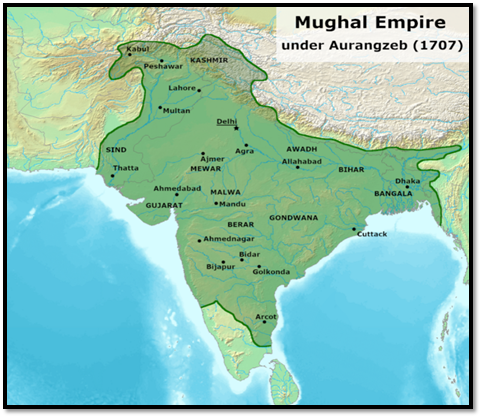26-Jun-2025
Aurangzeb
History
Why in news
Justice Urmila Joshi-Phalke of the Bombay High Court's Nagpur Bench recently granted bail to nine individuals arrested in connection with the March 17 unrest in Chhatrapati Sambhajinagar district, which arose amid demands concerning the removal of Mughal emperor Aurangzeb’s tomb.
About Aurangzeb
- Aurangzeb ascended the Mughal throne in 1658 AD and took the title Alamgir ("Conqueror of the World").
- He ruled for a remarkable 50 years.
- From 1658 to 1681, he remained in North India.
- After 1681, the focus of his rule shifted to the Deccan region.
Military Achievements and Conflicts
- Aurangzeb was a skilled military commander.
- He successfully conquered Bijapur and Golconda.
- His conflict with the Marathas, however, remained inconclusive.
- In 1681, his son Muhammad Akbar revolted, weakening Aurangzeb’s position, especially against the Rajputs.
Administration and Governance
- The last 25 years of Aurangzeb’s reign in the Deccan were marked by economic decline and maladministration.
- He implemented the Mansabdari system to maintain administrative order and discipline.
Religious and Cultural Aspects
- Despite his orthodox image, Aurangzeb appointed the highest number of Hindu generals in the Mughal army.
- He built the Moti Masjid inside the Red Fort, Delhi.
Architecture
- Aurangzeb constructed the Bibi ka Maqbara in memory of his wife.
- It is known as the Second Taj Mahal and features
- Detailed carvings
- Grand structures
- Mughal-style landscaped gardens
- Bibi Ka Maqbara was built by Aurangzeb in Aurangabad, Maharashtra, in the late 1600s as a tribute to his first wife, Dilras Bano Begum.
Religious Policy
- Aurangzeb followed a strict and orthodox Sunni Islamic policy throughout his rule.
- He promoted a puritanical interpretation of Islam and supported conservative religious scholars.
- Known for his personal piety, he strictly observed Islamic religious practices.
- He reimposed the Jizya tax on non-Muslims, which was viewed as unjust by Hindus and other minorities.
- Aurangzeb executed Guru Tegh Bahadur, the ninth Sikh Guru, for refusing to convert to Islam.
- This act of religious intolerance led to rising discontent and the Sikh rebellion against Mughal authority.
- In 1669, Aurangzeb issued a farman directing the demolition of prominent Hindu temples, including the Kashi Vishwanath Temple in Varanasi and the Keshavdev Temple in Mathura.
Deccan Policy
- Aurangzeb aimed to bring the Deccan Sultanates, especially Bijapur and Golconda, under direct Mughal control due to their political and economic importance.
- Annexation Campaigns: He led long military campaigns and captured Bijapur in 1686 and Golconda in 1687, annexing them into the Mughal Empire.
- Maratha Resistance: The Marathas, led by Shivaji and later Sambhaji, strongly opposed Mughal expansion, forcing Aurangzeb to invest heavily in fighting them.
- Economic Burden: The extended military operations drained Mughal finances due to the high cost of war and governance in the Deccan.
- Neglect of Other Regions: Aurangzeb’s focus on the Deccan led to administrative neglect in key areas like Bengal and Punjab.
- Impact on the Empire: The continuous warfare, suppression of local rulers, and resource exhaustion weakened the Mughal Empire, contributing to its decline after Aurangzeb’s death.
Preparing Through MCQWhich of the following monuments was built by Aurangzeb in memory of his wife Dilras Bano Begum? (1) Moti Masjid Answer: (3) Bibi Ka Maqbara |



